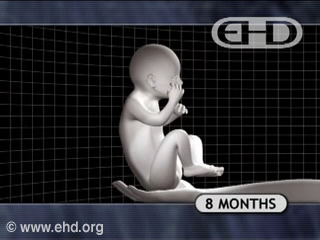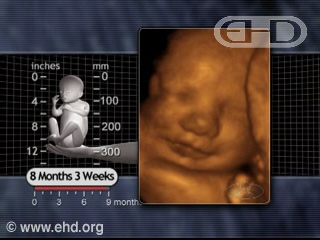Prenatal Form and Function – The Making of an Earth Suit
Unit 18: 8 to 9 Months (32 to 36 Weeks)
 Closer Look:
Closer Look:
 Applying the Science:
Applying the Science:

Copyright © 2006 EHD, Inc. All rights reserved.
We know that infants learn: what we don't know is how early and what they learn. Obviously, testing newborns to resolve these questions can pose some problems. They can't fill-in-the-blanks or answer questions. Therefore, researchers have to develop ingenious methods to discern newborn knowledge, making use of normal and observable infant behavior. Researchers test infant knowledge by testing expectations. If a baby has learned about something, he will have certain expectations about what will occur in a situation. If something different occurs, the infant will be surprised. Researchers determine infant surprise by measuring gaze length: keeping track of how long an infant focuses on something before looking away. If the baby is surprised, he or she will stare at something longer than normal. Infants also look at new things longer than they look at familiar things. Researchers use this phenomenon to determine whether an infant recognizes a portion of a story previously heard, by checking to see if the infant reacts to it as if it were a new event.

The amount of time this captivated baby spends staring at her toy is probably proportional to how familiar she is with the toy.
Researchers also test preferences. One way researchers test a newborn's preference is through "non-nutritive sucking." Here the researchers rig up a device attached to a pacifier which measures the intensity with which the infant sucks. Infants even only a few days old quickly learn the cause and effect relationship between their sucking and the stimulus. In one example, if the infant sucked at a certain rate, he heard a passage read in Spanish: if he sucked at a higher rate, he heard an English passage. In this way, an infant can control what she hears or sees, and therefore, researchers can determine what the infant prefers.
1 Kyra Karmiloff and Annette Karmiloff-Smith, Pathways to Language: From Fetus to Adolescent (Cambridge: Harvard, 2001), 14-17.
Studies suggest that towards the end of prenatal development, the fetus has been developing preferences and tastes based on prenatal experience. For instance, fetuses whose mothers consumed anise, the substance which gives licorice candy its flavor, showed a preference for anise after birth.1 Newborns without this fetal exposure disliked anise.

The fetus hears numerous sounds before birth, with the mother’s voice and heartbeat dominating other sounds. Studies show that after months of listening to the mother’s voice, the newborn prefers her voice to any other. The newborn also prefers female voices to male voices and familiar lullabies heard before birth to new lullabies after birth. Newborns can distinguish prose passages heard during the last 6 weeks of pregnancy from new passages, providing additional evidence of in utero memory formation and learning.2
The digestive system further develops as the lower esophageal (e-sof’a-je-al) sphincter (sfingk’ter), a valve leading to the stomach, begins functioning by 32 weeks.3 Blood-filtering groups of capillaries called glomeruli (glo-mar’yu-li) have completed their formation in the kidneys.4
At 35 weeks, the fetus has a firm hand grasp.5
| 1 | Schaal et al., 2000. 729. |
| 2 | Cheour-Luhtanen et al., 1996. 478; DeCasper and Fifer, 1980. 1174; DeCasper and Spence, 1986. 133; Gerhardt, 1990. 299; Querleu et al., 1989. 410, 417. |
| 3 | Hitchcock et al., 1992. 182. |
| 4 | Gasser, 1993. 371; Moore and Persaud, 2003. 290. |
| 5 | Moore and Persaud, 2003. 108. |






